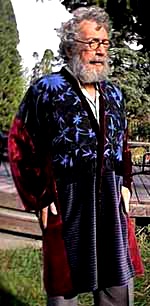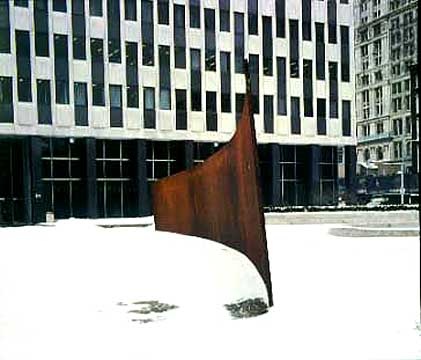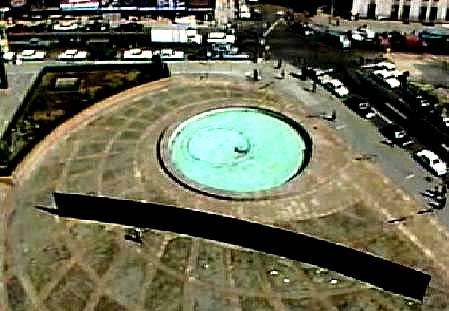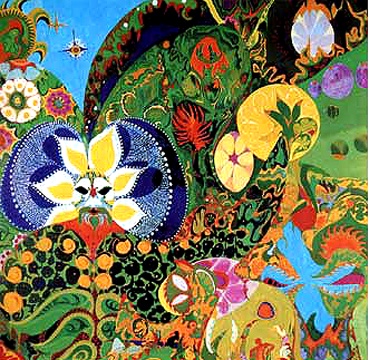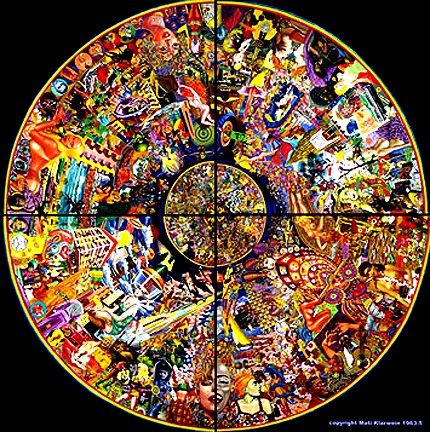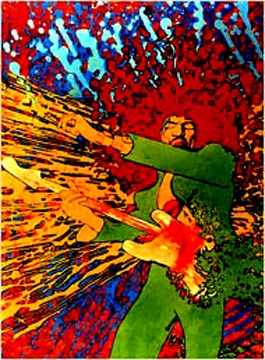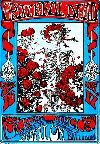Touring New York Museums with Media Artist Gerd Stern
Revisiting the Summer of Love Day Tripping through MoMA, Met, and Whitney
By: Mark Favermann - Sep 04, 2007
I get a little art-twitchy if I haven't visited New York City in a few months. June ran into August. Somehow, I forgot July. It was the middle of August, and I desperately needed my serious visual art hit. It's damn hard being an art and design junky. So, I booked a trip on Acela Express and scheduled nothing for that Wednesday.
Previously, I had called my old friend Gerd Stern and asked if we could meet and visit museums together. Even though we hadn't spent much quality time in nearly twenty years, we are the kind of friends who can pick up in the middle of our last sentence or at least last paragraph that we had spoken-a wonderful connection. I was particularly delighted because Gerd had three pieces in the Whitney Museum's Summer of Love, The Art of the Psychedelic Era show, and he wanted to share it with me.
Gerd Stern is one of the most fascinating figures of the last 60 years. We met and became great friends in the 1970's. I knew that there was something special about him. He has an amazing mind and an encyclopedic memory even now at 78. Gerd seems to have met, known, or been somehow involved with almost every artist, poet and cultural icon of the last six decades. He introduced Lenny Bruce to Hugh Heffner. He lived near Woodstock in the 60's at a communal church building that collectively did kinetic/media art under the name of USCO and developed the concept of three-dimensional, sculptural, collage poetry, light shows and commercially viable laser performances.
He started out as an immigrant child from Germany during the 1930's, grew up in New York and moved to San Francisco. Stern is a published poet and visual artist whose works are included in museum collections. Gerd was involved with the beat poets and writers, knew Jack Kerouac (who he remembers as a drunk, voyeur, and chauvinist). He met Beat poet, Allen Ginsberg, in a NYC city, locked door mental hospital. Gerd was eating and sleeping there for free as this was better than living in a car begging food from friends and acquaintances. He lived on a barge in Sausalito with poet/performer Maya Angelou. Later he wrote for Playboy Magazine.
In the '60's Stern invented lightshows, traveled and performed with Marshal McLuhan, created disco environments. In the 70's he organized Intermedia Corporation, in Cambridge, Mass. with some Harvard Business School types hoping to actually make money on the stuff he liked to do. He became an international cheese broker, married four times, had five or six children, continued doing his poetry and collaborated on fine arts projects. In recent years he has traveled all over the world doing retrospective exhibitions, readings and panels. Whoa, and that's just the tip of the iceberg.
After a three hour and ten minute smooth ride from Boston, I met him at the lobby of the Museum of Modern Art to see the Richard Serra sculptures. He looked the same but a little greyer and a bit frailer, but I told him that he looked good. He commented that I carried my added weight well. Friends are supportive of each other.
We maneuvered our way through overflowing art lovers and toward the disjointed exhibit. The earlier, more organic, and somehow more precious, smaller, minimalist works from the start of Serra's career were on the six floor; the newer giant environmental pieces were on the second floor, and still others were outside in the Sculpture Garden. Gerd and I were a little surprised by a few of his earlier experimental pieces but not necessarily in a positive way, yet one of his pieces was quite good.
Difficult to visually accept easily, his minimalist and prop pieces were the kind of art that museum curators seem to take seriously and exhibit at the time. We appreciated the undulating behemoths that were his latest works. This was heavy art, work that could be measured in tonnage as well as beauty and visual wonder. They represent feats of engineering and professional rigging. Some of the pieces actually weighed 200 tons but sat lightly in a visual sense!
This masterful retrospective exhibit "Richard Serra Sculpture: Forty Years" displays the vision of a formidable artist, who has radicalized and extended the definition of contemporary sculpture. This is the same artist who became a cause celebre due to his Jacob K. Javits Federal Court House Commission "Tilted Arc" which seemed to be hated by almost everyone involved except the artist and perhaps his attorneys and closest friends. Serra claimed that all of his sculpture created spatial tension and an elegant if not brutal presence. Currently, there is a documentary about new work in which he states that the sculpture is not functional but serves a function. "Tilted Arc" functioned in a negative way.
The major issues of all public art are the following: For the artist, it is generally aesthetic, financial and prestigious. For the public agency, it is political, financial and legal. For the public, it is aesthetic and sociological. In the best set of circumstances, these concerns should converge; in the case of "Tilted Arc" they did not.
Serra wants to involve the viewer in his work, both spatially and temporally. He is also interested in the physical properties of sculpture, its weight and materials. Cor-ten steel, a manufacturing material subject to external rust, is one of his favorite media. Massive rusted steel sculptures are not visually ingratiating to the uninitiated general public.
Almost from the beginning "Tilted Arc" was greeted with hostility. Two months after its installation, a petition with 1,300 signatures from federal employees working in and around the plaza, requesting the removal of the sculpture, was submitted to the GSA. The architect of the Javits Building, Alfred Easton Poor, sent a letter to GSA in the fall after the installation of the sculpture, objecting to "Tilted Arc" because it obstructed the view from one building to another and from the building to the fountain which was also located in the federal plaza. Poor's firm, which designed the building, was never consulted on the Serra commission.. A New York congressman and a federal judge also asked for it to be removed.
And so it went. Eventually "Tilted Arc" was removed. Serra sued the Feds for something like $40 million. Artists and sympathetic art critics voiced concerns about 1st Amendment Rights, Serra's suit was dismissed, but the NEA changed its public art procedures, and "Tilted Arc" is now somewhere in storage. Yet, no one, except for perhaps Richard Nixon, has ever resurrected their reputation and career like Richard Serra. Apparently, it has something to do with surviving bad times, aging/ maturing, and becoming a bit less confrontational.
After lunch Gerd and I left MoMA for the Whitney. We by-passed a long line and approached the ticket desk where the staff saluted Gerd and let us in. They seemed to relish the fact that one of the 60's artists liked to come back again and again to share the exhibit "Summer of Love: Art of the Psychedelic Era," through September 16, with friends and family. The exhibition was a step back in time to a period of my confused yet highly visually receptive youth. Colors swirled. Art Nouveau was transformed into primary harshness and music had a magical quality.
This was Age of Aquarius. Flower Power and Psychedelic art in a time of revolution, free love, and free thought. Individuals somehow worked in stylistically similar ways. Perhaps, it was the music, the politics, or arguably the drugs. It was a tumultuous time of intense social and political turmoil which is often defined historically by the civil rights movement, a counter culture, the Viet Nam War as well as sex, drugs, and rock 'n' roll. The artwork was an interesting mix of strong graphic design, interpretive photography, kinetic art, and multimedia exploration.
Artists of all kinds-visual, musical, poets, writers, filmmakers, even architects and designers attempted to create visionary and alternative lifestyles. They sought to shun rampant consumerism, middle-class complacency, conservative sexual and social values by embracing a liberating psychedelic potential through altered forms of perception. Sensory experiences were induced by visual effects intertwined with music, light, meditation, and hallucinogenic drugs. Major centers of this creativity were located in San Francisco, New York and London.
This was a time of creativity with Free Love, Hippies, Haight-Ashbury, flowers in your hair, Timothy Leary, Easy Rider, Woodstock, the Beatles and the Maharishee and letting your hair grow long. It stretched from the mid 1960s to the early 70's. Gerd Stern and USCO were at the center of all this, intimately connected, churning out multimedia art and happenings. His three pieces at this Whitney Show were a range of works from a silver Mylar environment room with a strobe light causing visual stops and starts ( Doc Edgerton of MIT taught USCO how to use strobes), a machine that lighted up and spun with words and images, and a painted "God Krishna" canvas integrated with neon. The USCO work stood out.
Gerd told me that the exhibit was put together by a couple of young energetic curators from the Tate Liverpool. The show opened at the Mersey River musum in 2005. It then traveled to Germany and eventually to the Whitney. He said that the best presentation was at the Whitney. He was pleased with the Whitney exhibit which flowed over two floors of the museum. In a couple of months, Gerd will go to Berlin as an artist in residence for a month. He has been speaking around the US and Canada for the last few years as well. Moral: Survival in the art world can make you have artistic resurrections and resuscitations.
Gerd left to go grocery shopping for his daunting and complex 94-year-old stepmother in New Jersey. He dropped me off at the Metropolitan Museum of Art. I was particularly interested in seeing the new Ancient Greek and Roman sculpture presentation.
I ambled up the stairs and quickly found the newly refurbished space on the left side of the grand entrance area. Spectacular is an understatement about the space. A comparable exhibition environment is at the British Museum's Ancient Egyptian area. The space at British Museum is perhaps even more spectacular due to the scale of objects. But, this would be personal taste.
Entering the Leon Levy and Shelby White Court, I found myself in the middle of a grand space that suggests a Roman courtyard. Many of the objects are masterpieces. We can touch the past with our eyes. I found the actual workmanship of various statues most inspiring. Upstairs, a fully decked out ornate chariot was wonderful. In side galleries, the early Etruscan pieces are minimalist icons. The Greek vases are always delightful. Some of the table implements and coins suggested a modernity that is a little unnerving. They were created so long ago, but have we really changed? In these galleries, we experience our Western cultural heritage.
There is much to comprehend and to culturally connect in the Met's new sculpture court. Many visits are probably necessary to focus upon diverse eras and styles. Bringing me back to reality, the cell phone rang, and I answered a call from my daughter. A young guard politely told me that cell phones were not allowed in the galleries. Modernity need not be everywhere.
Out front, I hailed a cab to Penn Station and took the 7 PM train back to Boston. I was home by 11. Perhaps, I was "home" all day in New York City as well?

